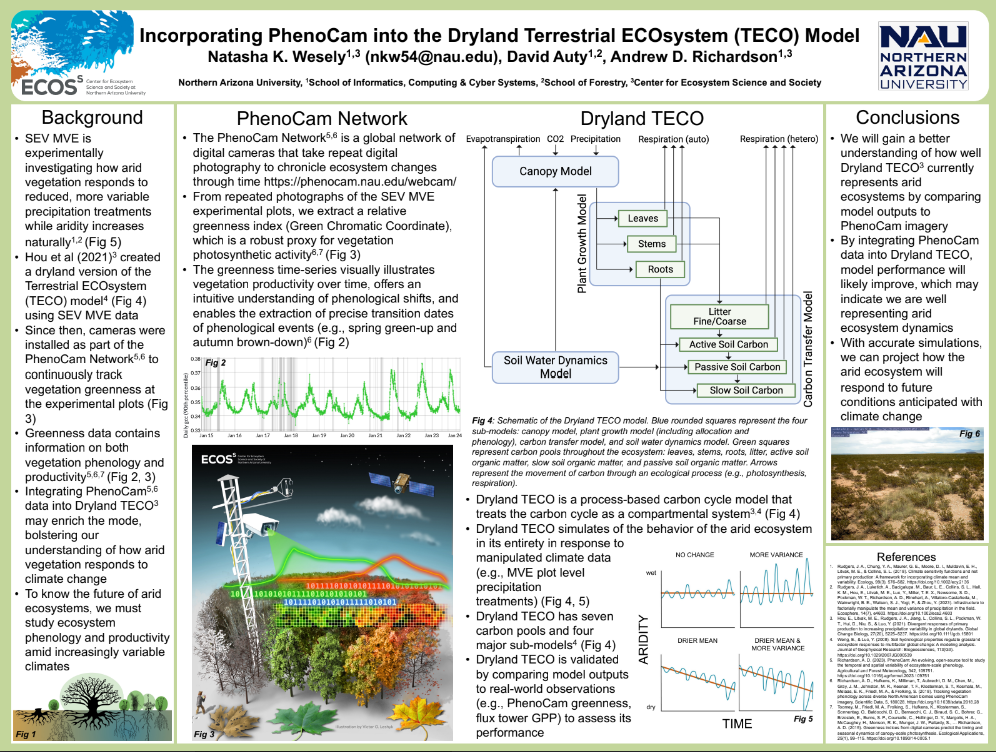Sevilleta Live
Daily-Updated PhenoCam Imagery
PhenoCams are cameras programmed to take images of vegetation at regular intervals. The images can be used to monitor the timing of different natural events such as wildflower blooms, but can also be used for more technical purposes such as determining plant health and growth by quantifying the greenness of the image’s pixels.
All five of the New Mexico Elevation Gradient flux tower sites run by Marcy Litvak’s Lab at the University of New Mexico that are part of the SEV LTER use PhenoCams to track vegetation dynamics. Scott Collins and Renee Brown set up the cameras at US-Seg (Desert Grassland) and US-Ses (Creosote Shrubland) in 2014 with Andrew Richardson’s Lab at Northern Arizona University. The Litvak Lab set up cameras at US-Wjs (juniper savanna) and US-Mpj (piñon-juniper woodland) in 2020 and 2013, respectively, and at US-Set (Plains Grassland) in 2023. Images from all sites are accessible through the PhenoCam network maintained by Andrew Richardson’s Lab.
In 2018, Scott Collins and Renee Brown installed cameras in the Monsoon Rainfall Manipulation Experiment (MRME) at Sevilleta NWR to monitor plant responses to watering with different amounts and frequencies. For more information about this project, see the Collins lab website.
In 2022, Andrew Richardson’s Lab also installed a series of PhenoCams at several of the flagship Mean-Variance Experiment sites. These will be used to monitor and model plant responses to long-term drought and year-to-year variability in precipitation. For an example of the work being done in the Richardson lab, see PhD student Natasha Wesely’s research poster below.
Below are just a few selected feeds from the Sevilleta PhenoCams. The complete set of images is available through the PhenoCam Network, which hosts an archive of over 60 million images from research sites around the world.
Photos update daily, so check back soon!
Grasslands
Eddyflux Sites


Monsoon Rainfall Manipulation Experiment (MRME)
Plots receive the same amount of supplemental water each monsoon season, but in different-sized “storms”: some are watered frequently with a smaller amount of water, and others are watered less frequently with more water.



Mean-Variance Experiment
Chihuahuan Desert Grassland
These images are taken in the plots at experimental block 3 of the black grama dominated Chihuahuan Desert MVE site. They represent all six of the mean-variance experimental treatments. Droughts plots receive 25% less precipitation than non-drought plots. High-variance plots are paired, and 50% of the precipitation that would have gone to the dry plot is collected and put onto its paired wet plot. These treatments are randomly flipped, so each year there is a chance of the pair’s treatments being reversed. For more information, see our experimental methods paper.






Shrubland
Eddyflux Site

Mean-Variance Experiment
Chihuahuan Desert Shrubland
These images are taken in the plots at experimental block 1 of the creosote bush dominated Chihuahuan Desert MVE site. They represent all six of the mean-variance experimental treatments. Droughts plots receive 25% less precipitation than non-drought plots. High-variance plots are paired, and 50% of the precipitation that would have gone to the dry plot is collected and put onto its paired wet plot. These treatments are randomly flipped, so each year there is a chance of the pair’s treatments being reversed. For more information, see our experimental methods paper.







